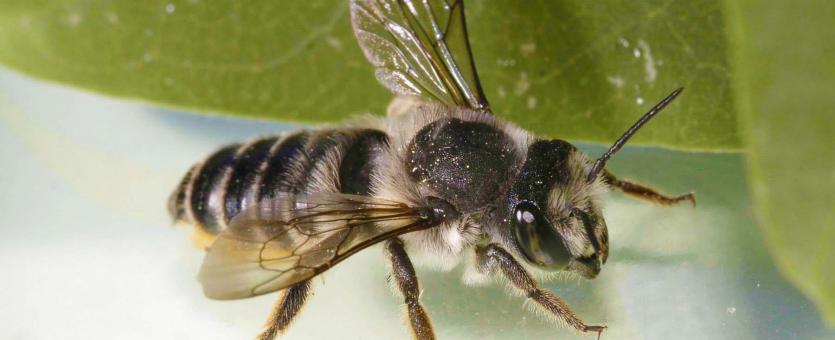
Leafcutter bees are common throughout Missouri from late spring into early autumn. All are solitary. They are dark-colored with several whitish hair bands across the abdomen. Pollen is carried exclusively on the underside of the abdomen, never on the hind legs. One sign of their presence is the rounded holes they cut in the leaves of plants.
There are about 130 species of leafcutter bees (Megachile spp.) in North America north of Mexico.
This page is about megachilid bees in genus Megachile; these are commonly called leafcutter bees. But the name "megachilid bee" can be used for any of several genera in the family Megachilidae; not all in the family are leafcutters.
Learn more about this and other megachilid bees on their family page.
Length: from about ¼–1 inch (varies with species).

Statewide.
Habitat and Conservation
Nests are in hollow twigs, stalks, holes in logs, in dried rolled-up leaves, or in the ground. Megachile species busily cut leaf and flower pieces from preferred plants and use them to build capsulelike cells. The great French entomologist J. Henri Fabre remarked about the industry of these insects: "If work is the best way to enjoy life, this one certainly has not been bored during the few weeks of her existence."
Food
Like many other bees, leafcutter bees eat pollen and nectar from flowers, and pollinate the flowers as they go. Unlike honeybees, which have so-called pollen baskets on their hind legs, leafcutter bees collect pollen on the undersides of their abdomens.
Life Cycle
These are solitary bees and don't live in hives. After fertilization, the females construct tubular nests in the soil or in some kind of elongated hole (as in a hollow twig). The nests are lined with small circles of leaves that the females clip from plants, and provisioned with nectar and pollen. Each chamber receives one egg. All of at least a dozen species of Megachile in Missouri overwinter as resting-stage young; some have two or more generations per year.
Human Connections
Several species are important pollinators of sunflowers. The alfalfa leafcutter bee (Megachile rotundata), the smallest in our state, was introduced from Europe and is often propagated for alfalfa pollination.
Ecosystem Connections
In addition to their role in pollination, these insects serve as food for a host of species, ranging from parasitic wasps that feed exclusively on their larvae, to birds, mammals, reptiles, and amphibians.






































